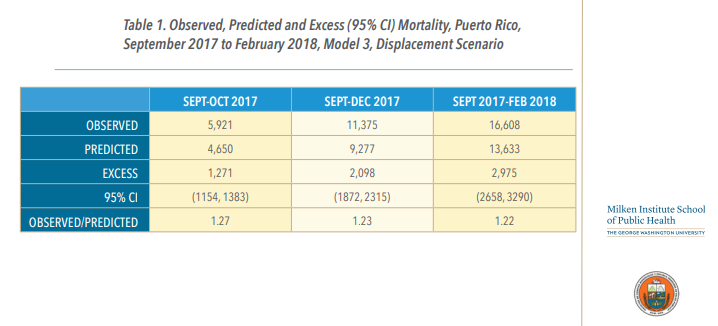No, President Trump is not correct that the official death toll has been exaggerated. While he's right that 3,000 people did not die in Hurricane Maria, there is evidence that nearly 3,000 people likely did die as a result of the storm and this is the statistic that is currently being reported/discussed.
The death toll of 2,975 is from this report by the School of Public Health at George Washington University. They are not claiming that nearly 3,000 people died during the hurricane, but that there were nearly 3,000 more deaths than expected in the months following the hurricane.
In other words, if past mortality rates predicted that 100 people would die from age-related issues in January and 125 people actually died, then the 25 people that were added to the list of deaths were likely caused by the hurricane.
As summarized in the report's methodology section:
We implemented the project as three studies, each with specific yet complementary methodologies. Our excess mortality study analyzed past mortality patterns (mortality registration and population census data from 2010 to 2017) in order to predict the expected mortality if Hurricane María had not occurred (predicted mortality) and compare this figure to the actual deaths that occurred (observed mortality).The difference between those two numbers is the estimate of excess mortality due to the hurricane.
...
Total excess mortality post-hurricane using the migration displacement scenario is estimated to be 2,975 (95% CI: 2,658-3,290) for the total study period of September 2017 through February 2018.
This number was estimated with a high amount of confidence by comparing expected population changes had Maria not occurred with actual population changes:
To perform this analysis, we obtained vital registration mortality data including deaths by age, sex and municipality of residence from the Puerto Rico Puerto Rico Vital Statistics Registry (PRVSR) for the period July 1, 2010 to February 28, 2018. We derived baseline estimates of population size in each month from annual census estimates of population size by age, sex and municipality of residence. Cumulative monthly population displacement after the storm in each month was estimated using Bureau of Transportation Statistics (BTS) data on monthly net domestic migration provided by the Puerto Rico Institute of Statistics and a survey of airline travelers provided by the Puerto Rico Planning Board (Planning Board 2018).
Using the ~8 years of past population statistics, the researchers were able to estimate the expected number of deaths in the few months after the hurricane with the actual number of deaths:
As a side note, the purpose of the report wasn't necessarily to provide a fully accurate death count. Rather, the purpose was to show why this exact situation, where death estimates are so varied and potentially inaccurate, is dangerous and why it shouldn't even happen in the first place. It was meant to act as a policy guide for improvements to Puerto Rican mortality assessments and communication during natural disasters, so that a disaster of this magnitude doesn't happen again:
RECOMMENDATIONS ON MORTALITY SURVEILLANCE FOR NATURAL DISASTERS
I. Strategic Objectives
To have a reliable and resilient institutional mortality surveillance process that provides trustworthy and accurate evidence during natural disasters to: Establish the magnitude of the impact of the disaster, identify areas and groups of highest risk, monitor the performance of public health protection and prevention, and inform policy-making and program implementation.

